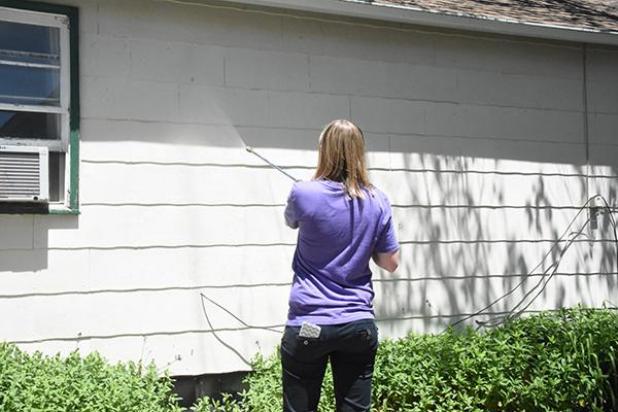
Pressure washing can be used to restore the exterior of your home, as long as the pressure is appropriate for the surface. — The Holyoke Enterprise | Johnson Publications
5 tips to keep in mind...
Power and pressure washers are powerful and easy-to-use tools for scouring hard surfaces like brick, wood and concrete. They can transform the flow from a simple outdoor tap into a high-pressure jet capable of stripping away years of grease and caked-in dirt.
But while the business end of a washer might look like something you’d attach to a garden hose, consumer-grade washers are still strong enough to strip the paint off of a house and cause serious injury.
Before you buy or rent a power or pressure washer this summer, knowing a few facts about the tool could save you potential headaches and damage to the most delicate parts of your home.
Choose the right tool for the job
Although pressure and power washing is rarely differentiated, unlike pressure washers, power washers include a heating element that make them especially useful for removing deep stains.
The near-boiling temperature of the water used in power washing also means they are more challenging and potentially dangerous to untrained users.
Pressure and power washers both use an electric or gasoline-powered pump to force water through an interchangeable nozzle. Nozzles are used to control the angle of spray, which also affects the pressure of the water being ejected.
While pressure washing relies entirely on water pressure to blast away dirt and debris, power washing harnesses the additional power of heat.
For surfaces that can handle the heat — including sidewalks, driveways and other areas paved with concrete— power washing may be significantly faster and more effective than pressure washing.
For softer surfaces or jobs that require a finer touch, it’s best to stick with pressure washers to avoid causing unnecessary damage.
Suit up before you wash
Before turning on your machine, make sure your hands, feet and eyes are protected from potential contact with the washer stream and flying pieces of debris.
Water exits the nozzle of a washer under thousands of pounds of pressure per square inch, which is more than powerful enough to remove skin or even penetrate deep into the body without leaving an entry wound.
For reference, the average garden hose emits water at about 40 pounds per square inch.
Goggles protect the eyes from chips of rock, wood or other debris that may be kicked up while spraying, and gloves and boots shield the hands and feet from accidentally coming into contact with the water.
Even if a power or pressure washer-related injury appears minor, seek immediate medical attention, as additional water injected deeper into the body could cause severe health problems.
Avoid running gas washers indoors
Garages or other large indoor spaces paved with concrete may be prime candidates for power or pressure washing, especially if the floor is stained with oil or automotive grease.
Many larger washers are powered by gasoline-fueled engines, which require the same ventilation as other gas-fed machines to be used safely. When purchasing or renting a washer to clean an indoor space, avoid gas-powered machines, as they produce toxic carbon monoxide gas that can become concentrated indoors.
Gasoline-powered machines are also louder than electric machines. If you must operate a gas washer inside, wear ear protection to avoid damaging your hearing over time.
Watch out for nozzle kickback
When you turn on your washer, be prepared for a kick: the jet of water produced by a washer can create a considerable amount of backward force, with stronger washers producing a bigger kickback.
The backward push produced by a washer can easily push an unprepared user off of a ladder or ledge. If your job site includes an elevated surface, consider buying an extension wand to wash from the ground.
Even if you’re standing in level ground, make sure you have stable footing.
Washers may expel several gallons of water per minute, which can make for a wet and slippery floor fast. Wear the right footwear and stand on an appropriately grippy surface to avoid losing your footing.
Identify and take care of electrical hazards ahead of time
Make sure any and all sources of electricity are protected before you start washing. This may seem like a no-brainer, but it can be easy to miss a frayed cord or painted-over outlet if you don’t scan your job site before starting to wash.
An uninsulated cord sitting in a puddle of water may cause a washer to malfunction or deliver a powerful shock.
Cover any exposed outlets with plastic and make sure any and all cables are fully protected before you start washing, especially when using an electric washer.
Click here to read the entire "Home Improvement" special section online for free.
